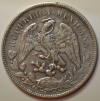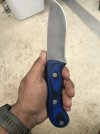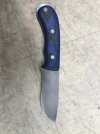Stacy E. Apelt - Bladesmith
ilmarinen - MODERATOR
Moderator
Knifemaker / Craftsman / Service Provider
- Joined
- Aug 20, 2004
- Messages
- 38,174
Well, one reason that Mexican coins were used from California to Texas was that there were lots of them ... since those places used to be in Mexico. The silver coins were still in common use in lower California and the border states well into the 20th century (same way with Canadian coins accepted in the northern states).
Mexican coins varied a lot in silver content from as low as 30% to just above 90%, but in the 1800's, officially, most were .907% fine silver. US coins from the mid 1800's to 1964 were .900 fine silver. So, technically, there was more silver in a Mexican coin that a US coin. The problem was that the actual content of 8 reals and silver pesos varied from mint to mint and ran from 80% to 90%.
However, the biggest reason that they were used is the silversmiths, both Hispanic and Native American, were used to working with the coins as their source of silver, and the dies and punches they used fit the coins that they and their grandfathers learned on. US and English silversmiths were used to working with sterling silver sheets (92.5% silver), which was much more expensive due to manufacturing costs. Often, silver sheets were made from melting silver coins and a little extra copper to make it roll out easier. The products made were labeled "Coin Silver". Lots of silverware and pocket watch cases bear such markings. Coin silver was usually 80% to 85% silver.
I also think it is part nostalgia for the old "wild west" days and former times when Mexico and Spain ruled most of North America west of the Mississippi.
And, let's face it, an 8-real or silver peso with the Mexican eagle and snake looks a lot cooler on a cowboy than the rather ordinary US eagle.


Mexican coins varied a lot in silver content from as low as 30% to just above 90%, but in the 1800's, officially, most were .907% fine silver. US coins from the mid 1800's to 1964 were .900 fine silver. So, technically, there was more silver in a Mexican coin that a US coin. The problem was that the actual content of 8 reals and silver pesos varied from mint to mint and ran from 80% to 90%.
However, the biggest reason that they were used is the silversmiths, both Hispanic and Native American, were used to working with the coins as their source of silver, and the dies and punches they used fit the coins that they and their grandfathers learned on. US and English silversmiths were used to working with sterling silver sheets (92.5% silver), which was much more expensive due to manufacturing costs. Often, silver sheets were made from melting silver coins and a little extra copper to make it roll out easier. The products made were labeled "Coin Silver". Lots of silverware and pocket watch cases bear such markings. Coin silver was usually 80% to 85% silver.
I also think it is part nostalgia for the old "wild west" days and former times when Mexico and Spain ruled most of North America west of the Mississippi.
And, let's face it, an 8-real or silver peso with the Mexican eagle and snake looks a lot cooler on a cowboy than the rather ordinary US eagle.





